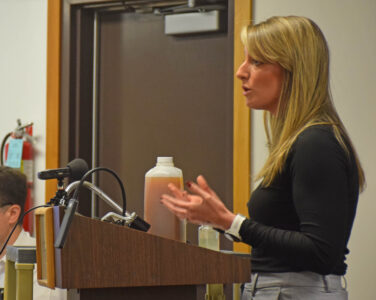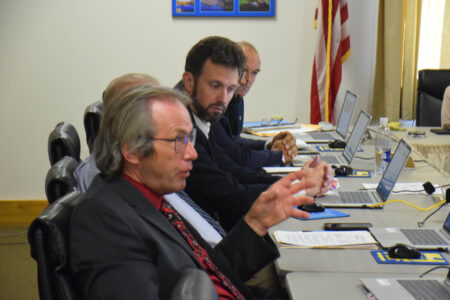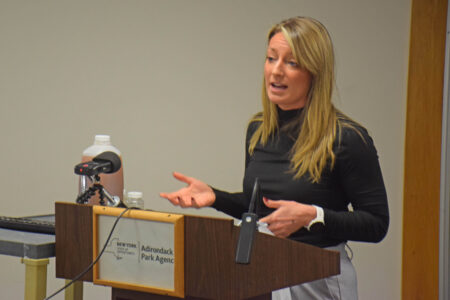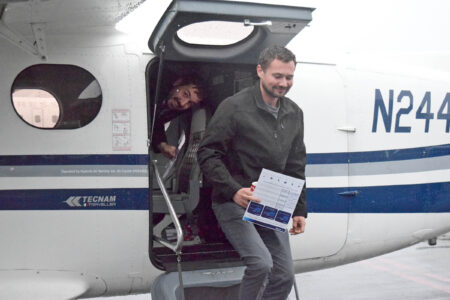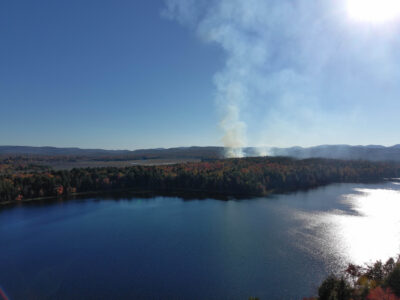‘We can fix it. We just can’t afford to.’
With samples in hand, Mayor Fontana takes Tupper’s water woes before APA
- Tupper Lake village Mayor Mary Fontana speaks at the Adirondack Park Agency monthly meeting in Ray Brook on Thursday. Fontana highlighted various attributes of Tupper Lake, while devoting much of her presentation to the community’s ongoing water quality issues. The jug at the podium is a recent water sample from one of the wells. (Enterprise photo — Chris Gaige)
- Adirondack Park Local Government Review Board Chairman Gerald “Jerry” Delaney speaks at the Adirondack Park Agency monthly meeting in Ray Brook on Thursday after a presentation by Tupper Lake village Mayor Mary Fontana. During her presentation, Fontana highlighted various attributes of Tupper Lake, while devoting much of it to the community’s ongoing water quality issues. (Enterprise photo — Chris Gaige)
- Tupper Lake village Mayor Mary Fontana speaks at the Adirondack Park Agency monthly meeting in Ray Brook on Thursday. Fontana highlighted various attributes of Tupper Lake, while devoting much of her presentation to the community’s ongoing water quality issues. The jug at the podium is a recent water sample from one of the wells. (Enterprise photo — Chris Gaige)
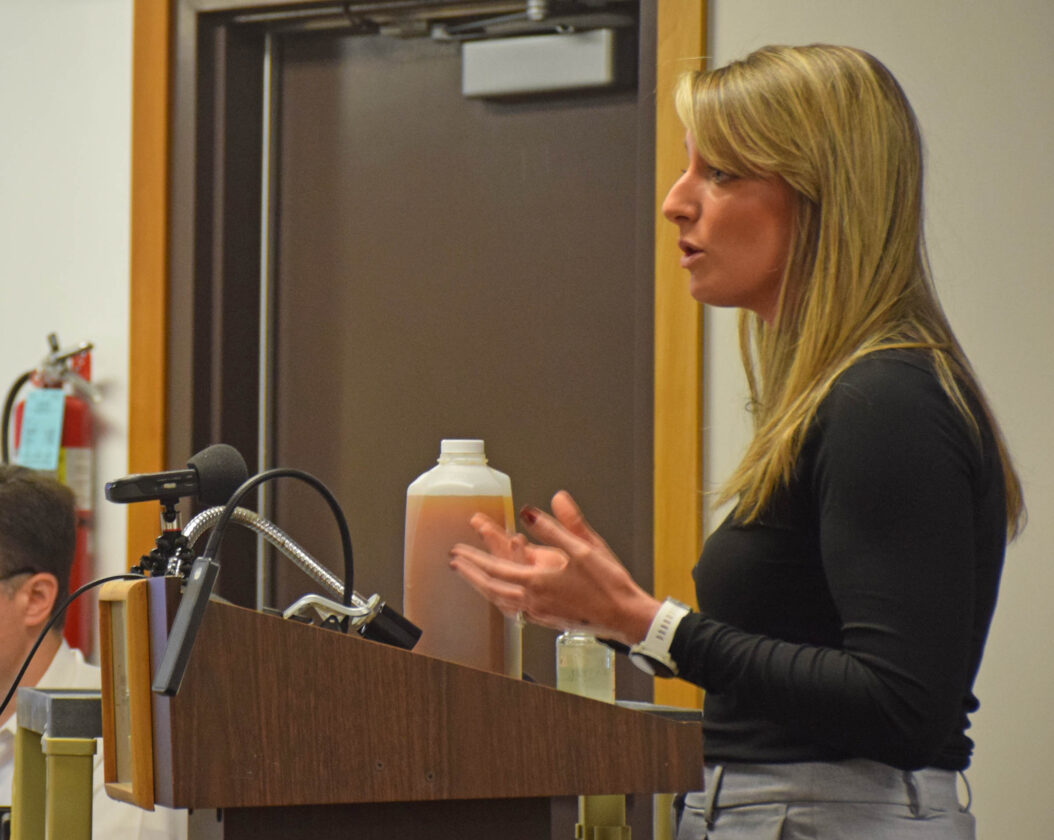
Tupper Lake village Mayor Mary Fontana speaks at the Adirondack Park Agency monthly meeting in Ray Brook on Thursday. Fontana highlighted various attributes of Tupper Lake, while devoting much of her presentation to the community’s ongoing water quality issues. The jug at the podium is a recent water sample from one of the wells. (Enterprise photo — Chris Gaige)
RAY BROOK — Tupper Lake village Mayor Mary Fontana warned the audience in advance that there would be a jump scare.
Some time after taking to the lectern at the Adirondack Park Agency’s October meeting on Thursday in Ray Brook, Fontana held up a half-gallon jug of post-treatment water from the village.
It could have been mistaken for apple cider.
The water’s color is from a heavy concentration of iron and manganese coming from groundwater wells near Pitchfork Pond, from which the village sources much of its water supply. The wells were not built to sequester such quantities of iron and manganese. When the wells were drilled in 2018, the pilot data and initial runs were clear.
About 18 months later, the water began turning brown. Iron and manganese had infiltrated the water supply. Since then, brown water has been a reality of life for Tupper Lakers.
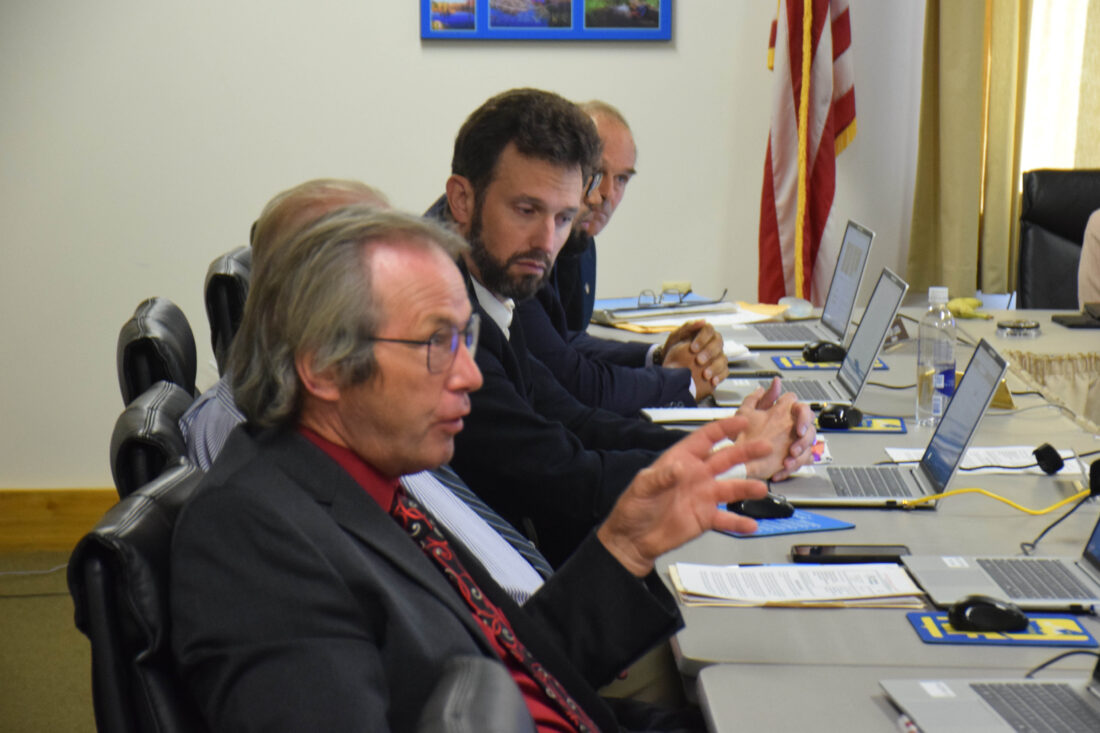
Adirondack Park Local Government Review Board Chairman Gerald “Jerry” Delaney speaks at the Adirondack Park Agency monthly meeting in Ray Brook on Thursday after a presentation by Tupper Lake village Mayor Mary Fontana. During her presentation, Fontana highlighted various attributes of Tupper Lake, while devoting much of it to the community’s ongoing water quality issues. (Enterprise photo — Chris Gaige)
Fontana was presenting as part of the APA’s community spotlight series. Though Fontana spent much of her time touting Tupper’s success stories — such as a revitalized downtown, enhanced waterfront and various seasonal events — she acknowledged that these are largely overshadowed by the water, an issue that has loomed large there for the last two decades.
Fontana, who was elected mayor in 2023 after eight years as a Tupper Lake Town Board member, said the troubles began in the mid-2010s when the Environmental Protection Agency found elevated levels of potentially carcinogenic chemical byproducts in the water.
At the time, it was being sourced from Simon Pond and Big Tupper Lake. When it was mixed with chlorine, it produced trihalomethanes and haloacetic acids, which are linked to an increased risk for cancer after prolonged exposure. Chlorine is commonly used by municipalities to sanitize water so that it can be consumed.
The village had dug those new groundwater wells to try to remedy that. After the water turned brown, it was clear the design wasn’t adequate, in filtration or capacity, Fontana explained.
“No iron or manganese sequestration was included in part of the design when the wells were originally built and when they went live,” she said. “We also found out that the wells did not have capacity to serve the entire community, so we had to leave the treatment plant on Simon Pond live. So we’re still drawing our water from Simon Pond.”
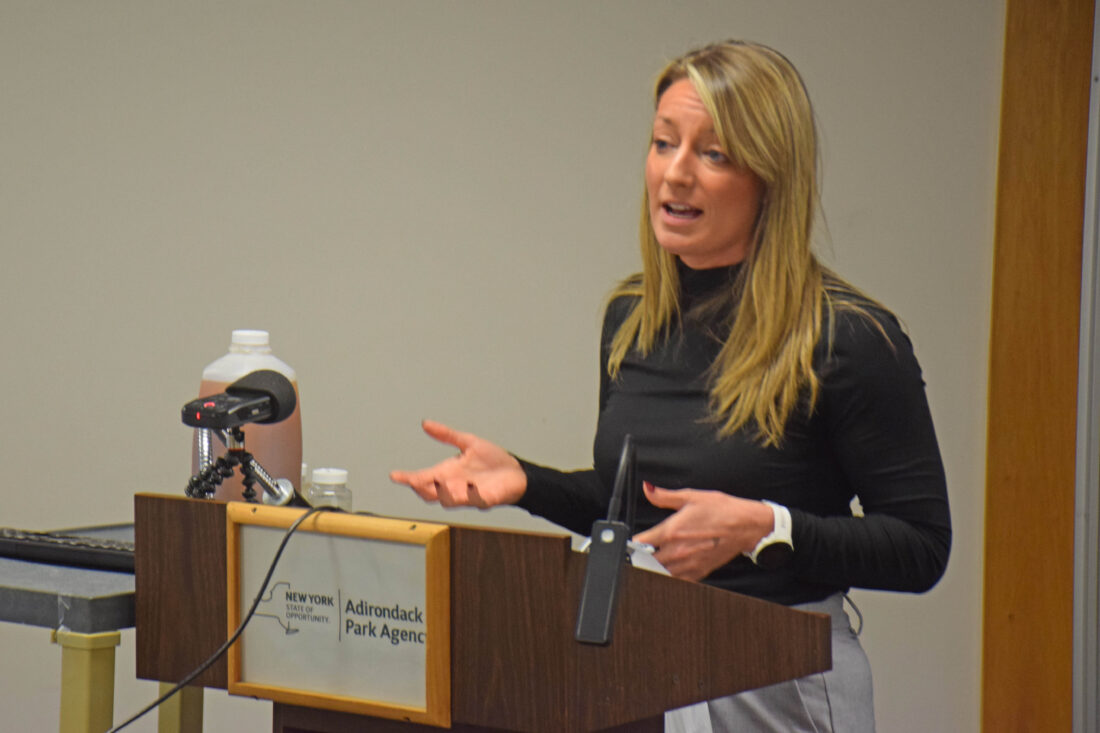
Tupper Lake village Mayor Mary Fontana speaks at the Adirondack Park Agency monthly meeting in Ray Brook on Thursday. Fontana highlighted various attributes of Tupper Lake, while devoting much of her presentation to the community’s ongoing water quality issues. The jug at the podium is a recent water sample from one of the wells. (Enterprise photo — Chris Gaige)
The half-gallon sample was taken from a hot water tank on Water Street. While most of the village’s water supply is not as discolored as that, things aren’t much better around town. Fontana had several other water samples with her, two raw, another treated from Water Street and one treated chlorinated cold water sample.
While the last was the clearest of the samples, even that had visible particles of Iron.
The samples were all drawn on Saturday and were to be “gifted” to Gov. Kathy Hochul during her intended visit to Tupper Lake for the Adirondack Rail Trail and train station project completions as a reminder of how dastardly the water crisis there remains.
Hochul ultimately did not attend the ceremony, so Fontana offered the water to Hochul’s North Country representative, Alison Webbinaro. While she did not take the water, Webbinaro took photos and said she would share those with the governor, according to Fontana.
With the water jugs and jars still in her trunk, Fontana figured they would make apt props for her presentation. As illustrative as the water photos in her presentation were, Fontana noted that looking at an actual physical sample was a “jarring” reminder of what her community has been experiencing for the last several years. It was something that Adirondack Park Local Government Review Board Executive Director Gerald “Jerry” Delaney noted when it turned to questions after Fontana’s presentation.
“I think most of us have probably heard about the story, but we haven’t been impacted by the story,” he began. “Why does your water look like apple cider?”
Though Delaney doesn’t have a vote on the APA board, he has a seat at the table, literally and figuratively. As the local government review board’s director, he often provides advice to APA board members on what issues are pressing to local governments, and what perspective they might come at them from. He said iron and manganese-laden water supplies are a park-wide problem, noting that the town of Indian Lake faced a similar predicament.
“This is an issue the state of New York has to battle,” he said. “We should all have clear water and clean air. I think we have a constitutional amendment that says that, but where is the help coming from to make that happen?”
Article I, Section 19 of the state constitution states that, “Each person shall have a right to clean air and water, and a healthful environment.” It was ratified by voters in 2021, garnering 70.1% of the vote statewide.
Delaney said finding funding is the most difficult aspect of trying to live up to the text, something that was, unfortunately, far from unique to Tupper Lake’s water quality situation. Fontana noted that there’s a solution to Tupper Lake’s case. It has a $20 million price tag, billed back to 2,000 customers.
“So the plan moving forward — the only plan that is sustainable and affordable to our community — is to treat the water at the wells and take Simon Pond offline,” she said. “To do that, we need to drill a third well and we need to build a new water treatment facility that can remove the iron and manganese from the water and deliver clear water to the community.”
Fontana added that the village currently has around $9 million in debt from the two existing wells drilled in 2018, even as they failed in their mission to deliver clean water.
“That’s really the crux of our problem,” she said. “We can fix it. We just can’t afford to.”
Several APA board members asked related questions about the water situation. Rush Holt, of Clinton County, inquired about seasonal fluctuations in water use from a surge of visitors. Fontana confirmed that summer sees the highest use. Benita Law-Diao, of Albany County, asked if aging infrastructure was contributing the issue. Fontana said that while the pipelines are “certainly” old in some parts of Tupper Lake, that wasn’t negatively impacting the concentration of iron and manganese.
“That’s coming directly from the groundwater,” she said.
In his first meeting as APA Board Chair, Mark Hall, of St. Lawrence County, lauded Fontana’s depth of knowledge on the issue. Hall is a certified water operator and currently serves as the Star Lake district’s water superintendent.
Fontana began the water portion of her presentation by acknowledging it was a problem that most listeners were already aware of, and that as a land use planning state agency, the APA wasn’t in a position to directly help the situation. Regardless, its significance warranted as much of a spotlight as she could give it, Fontana said.
“I’ll never miss an opportunity to stand up in front of a bunch of influential people and share our challenges and ask for help,” she said.

